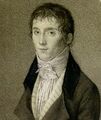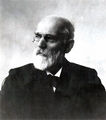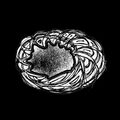Template:Selected anniversaries/March 7: Difference between revisions
No edit summary |
No edit summary |
||
| Line 55: | Line 55: | ||
||1922: Axel Thue dies ... mathematician, known for highly original work in diophantine approximation, and combinatorics. He stated in 1914 the so-called word problem for semigroups or Thue problem, closely related to the halting problem. Pic. | ||1922: Axel Thue dies ... mathematician, known for highly original work in diophantine approximation, and combinatorics. He stated in 1914 the so-called word problem for semigroups or Thue problem, closely related to the halting problem. Pic. | ||
||1928: Robert Abbe dies ... surgeon and radiologist. Pic. | |||
||1928: Ray Kunze born ... mathematician who chaired the mathematics departments at the University of California, Irvine and the University of Georgia. His mathematical research concerned the representation theory of groups and noncommutative harmonic analysis. Pic. | ||1928: Ray Kunze born ... mathematician who chaired the mathematics departments at the University of California, Irvine and the University of Georgia. His mathematical research concerned the representation theory of groups and noncommutative harmonic analysis. Pic. | ||
| Line 62: | Line 64: | ||
File:Klaus Fuchs.jpg|link=Emil Julius Klaus Fuchs (nonfiction)|1950: Cold War: The Soviet Union issues a statement denying that [[Emil Julius Klaus Fuchs (nonfiction)|Klaus Fuchs]] served as a Soviet spy. | File:Klaus Fuchs.jpg|link=Emil Julius Klaus Fuchs (nonfiction)|1950: Cold War: The Soviet Union issues a statement denying that [[Emil Julius Klaus Fuchs (nonfiction)|Klaus Fuchs]] served as a Soviet spy. | ||
||1951: William Draper Harkins dies ... chemist, notably for his contributions to nuclear chemistry. Harkins researched the structure of the atomic nucleus and was the first to propose the principle of nuclear fusion, four years before Jean Baptiste Perrin published his theory in 1919-20. His findings enabled, among other things, the development of the H-bomb. Pic search | ||1951: William Draper Harkins dies ... chemist, notably for his contributions to nuclear chemistry. Harkins researched the structure of the atomic nucleus and was the first to propose the principle of nuclear fusion, four years before Jean Baptiste Perrin published his theory in 1919-20. His findings enabled, among other things, the development of the H-bomb. Pic search. | ||
||1954: Otto Diels dies ... chemist and academic, Nobel Prize laureate. Pic. | ||1954: Otto Diels dies ... chemist and academic, Nobel Prize laureate. Pic. | ||
| Line 68: | Line 70: | ||
||1954: Ludwik Hirszfeld dies ... microbiologist and serologist. He is considered a co-discoverer of the inheritance of ABO blood types. Pic. | ||1954: Ludwik Hirszfeld dies ... microbiologist and serologist. He is considered a co-discoverer of the inheritance of ABO blood types. Pic. | ||
||1958: John Ronald Womersley dies ... mathematician and computer scientist who made important contributions to computer development, and hemodynamics. Nowadays he is principally remembered for his contribution to blood flow, fluid dynamics and the eponymous Womersley number, a dimensionless parameter | ||1958: John Ronald Womersley dies ... mathematician and computer scientist who made important contributions to computer development, and hemodynamics. Nowadays he is principally remembered for his contribution to blood flow, fluid dynamics and the eponymous Womersley number, a dimensionless parameter characterizing unsteady flow. Pic search. | ||
||1962: Eduard Rüchardt dies ... physicist. In modern times Rüchardt is mainly noted for the experiment named after him. However, Rüchardt's chief topic was the study of canal rays. Pic search | ||1962: Eduard Rüchardt dies ... physicist. In modern times Rüchardt is mainly noted for the experiment named after him. However, Rüchardt's chief topic was the study of canal rays. Pic search. | ||
||1964: Samuel S. Wilks dies ... American mathematician and academic who played an important role in the development of mathematical statistics, especially in regard to practical applications. During World War II he was a consultant with the Office of Naval Research. Both during and after the War he had a profound impact on the application of statistical methods to all aspects of military planning. Pic search | ||1964: Samuel S. Wilks dies ... American mathematician and academic who played an important role in the development of mathematical statistics, especially in regard to practical applications. During World War II he was a consultant with the Office of Naval Research. Both during and after the War he had a profound impact on the application of statistical methods to all aspects of military planning. Pic search. | ||
||1966: Georg Faber dies ... Faber's most important work was on the polynomial expansion of functions. This is the problem of expanding an analytical function in an area bounded by a smooth curve as a sum of polynomials, where the polynomials are determined by the area. These polynomials are now known as 'Faber polynomials' and first appear in Faber's 1903 paper Über polynomische Entwickelungen published in Mathematische Annalen. Another important paper which he also published in Mathematische Annalen, this time in 1909, was Über stetige Funktionen. In this paper he introduced the 'hierarchical basis' and explicitly used it for the representation of functions. In fact Faber was building on the idea of Archimedes who computed approximately using a hierarchy of polygonal approximations of a circle. Only in the 1980s was Faber's idea seen to be an important ingredient for the efficient solution of partial differential equations. One further achievement of Faber is worthy of mention. In 1894 Lord Rayleigh made the following claim:" ... given a fixed area of ox-hide to make a drum, the ground tone is lowest if you make your drum circular. " Two mathematicians independently verified Rayleigh's conjecture, Faber and Edgar Krahn. *SAU Pic search | ||1966: Georg Faber dies ... Faber's most important work was on the polynomial expansion of functions. This is the problem of expanding an analytical function in an area bounded by a smooth curve as a sum of polynomials, where the polynomials are determined by the area. These polynomials are now known as 'Faber polynomials' and first appear in Faber's 1903 paper Über polynomische Entwickelungen published in Mathematische Annalen. Another important paper which he also published in Mathematische Annalen, this time in 1909, was Über stetige Funktionen. In this paper he introduced the 'hierarchical basis' and explicitly used it for the representation of functions. In fact Faber was building on the idea of Archimedes who computed approximately using a hierarchy of polygonal approximations of a circle. Only in the 1980s was Faber's idea seen to be an important ingredient for the efficient solution of partial differential equations. One further achievement of Faber is worthy of mention. In 1894 Lord Rayleigh made the following claim:" ... given a fixed area of ox-hide to make a drum, the ground tone is lowest if you make your drum circular. " Two mathematicians independently verified Rayleigh's conjecture, Faber and Edgar Krahn. *SAU Pic search. | ||
||1971: Richard Montague dies ... mathematician and philosopher. Pic. | ||1971: Richard Montague dies ... mathematician and philosopher. Pic. | ||
| Line 90: | Line 92: | ||
||1997: Edward Mills Purcell dies ... physicist who shared the 1952 Nobel Prize for Physics for his independent discovery (published 1946) of nuclear magnetic resonance in liquids and in solids. Nuclear magnetic resonance (NMR) has become widely used to study the molecular structure of pure materials and the composition of mixtures. Pic. | ||1997: Edward Mills Purcell dies ... physicist who shared the 1952 Nobel Prize for Physics for his independent discovery (published 1946) of nuclear magnetic resonance in liquids and in solids. Nuclear magnetic resonance (NMR) has become widely used to study the molecular structure of pure materials and the composition of mixtures. Pic. | ||
||1999: Sidney Gottlieb dies ... chemist, theorist, and poisoner. Pic search | ||1999: Sidney Gottlieb dies ... chemist, theorist, and poisoner. Pic search. | ||
||1999: Stanley Kubrick dies ... director, producer, and screenwriter ... one of the greatest and most influential directors in cinematic history. His films, which are mostly adaptations of novels or short stories, cover a wide range of genres, and are noted for their realism, dark humor, unique cinematography, extensive set designs, and evocative use of music. Pic. | ||1999: Stanley Kubrick dies ... director, producer, and screenwriter ... one of the greatest and most influential directors in cinematic history. His films, which are mostly adaptations of novels or short stories, cover a wide range of genres, and are noted for their realism, dark humor, unique cinematography, extensive set designs, and evocative use of music. Pic. | ||
||2008: David Gale dies ... mathematician and economist. He was a professor emeritus at the University of California, Berkeley, affiliated with the departments of mathematics, economics, and industrial engineering and operations research. He has contributed to the fields of mathematical economics, game theory, and convex analysis. Pic search | ||2008: David Gale dies ... mathematician and economist. He was a professor emeritus at the University of California, Berkeley, affiliated with the departments of mathematics, economics, and industrial engineering and operations research. He has contributed to the fields of mathematical economics, game theory, and convex analysis. Pic search. | ||
||2017: Hans Georg Dehmelt dies ... physicist, who was awarded Nobel Prize in Physics in 1989, for co-developing the ion trap technique (Penning trap) with Wolfgang Paul, for which they shared one-half of the prize (the other half of the Prize in that year was awarded to Norman Foster Ramsey). Their technique was used for high precision measurement of the electron magnetic moment. Pic. | ||2017: Hans Georg Dehmelt dies ... physicist, who was awarded Nobel Prize in Physics in 1989, for co-developing the ion trap technique (Penning trap) with Wolfgang Paul, for which they shared one-half of the prize (the other half of the Prize in that year was awarded to Norman Foster Ramsey). Their technique was used for high precision measurement of the electron magnetic moment. Pic. | ||
Revision as of 06:10, 13 April 2020
1765: Inventor Nicéphore Niépce born. He will invent heliography, a technique he will use to create the world's oldest surviving product of a photographic process.
1788: Physicist and academic Antoine César Becquerel born. He will pioneer the study of electric and luminescent phenomena.
1875: Flying bison (Bison pterobonasus) sighted near Roswell, New Mexico.
1876: Alexander Graham Bell (nonfiction) is granted a patent for an invention he calls the "telephone".
1886: Mathematician and physicist G. I. Taylor born. He will make major contributions to fluid dynamics and wave theory.
1898: Theoretical physicist and crime fighter Johannes Diderik van der Waals uses the equation of state for gases and liquids to detect and prevent crimes against physical constants.
1917: Pioneering computer scientist and programmer Betty Holberton born. She will be one of the six original programmers of ENIAC, the first general-purpose electronic digital computer, and the inventor of breakpoints in computer debugging.
1950: Cold War: The Soviet Union issues a statement denying that Klaus Fuchs served as a Soviet spy.
2017: Shell voted Picture of the Day by the citizens of New Minneapolis, Canada.
2019: Steganographic analysis of Confessions of a Quantum Artist-Engineer (1) unexpectedly reveals "at least two-hundred and fifty-six kilobytes" of previously unknown Gnomon algorithm functions.









